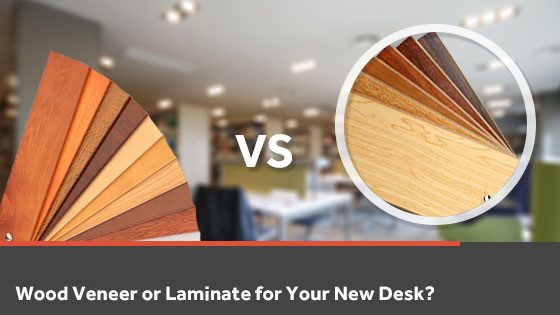When you look at the image above, can you tell which is wood veneer and which is laminate?
There used to be a time where laminate was considered to be far inferior to real wood. However, technology and construction methods have narrowed that gap in the eyes of many. This makes laminate and wood veneer office desks more comparable in appearance than ever before and giving shoppers a broader range of great-looking options to choose from.
Of course, life is about more than just looks and appearance. Durability and price also come into play when choosing office furniture and that could dictate whether a wood veneer or laminate desk is the right choice for your office and unique needs.
In this article, we will explain the differences between the two finishes and outline the advantages of choosing each finish. Both wood veneer and laminate have unique benefits, and we want to help you make the right choice for your office.
What is Wood Veneer?
If you see a high-powered executive’s office in a movie, there is probably a large, beautiful hardwood desk in their office. These desks are undeniably stunning in appearance, making them a fantastic focal piece in a room as well as an excellent surface for getting work done.
The primary downside of solid hardwood desks is the significant price and maintenance requirement. These desks are constructed of brilliant pieces of wood, and their price point reflects that.
Wood veneer is a nice compromise that gives the appearance of a solid wood desk while reducing the cost. This is done by applying a thin layer of real wood to a base of less expensive wood like plywood. This construction process gives the appearance of real wood that many people love. The beauty of the wood, as well as the blemishes that give the wood character, are able to stand out.
One downside to choosing wood veneer is the durability. Wood is prone to scratching and gouging that can quickly wear down the appearance of the desk and ruin the classy, upscale look you were initially seeking.
To maintain the appearance of a wood veneer desk often requires periodic maintenance and cleaning with wood oils and protectant seals. Even still, water spills can permanently mark a wood veneer desk if they are not cleaned up right away.
What is a Laminate Desk?
Laminate is designed to give the appearance of wood while offering a cost-friendly solution for offices that are more focused on their budget. There are two types of laminate used to build office furniture, thermofused and high-pressure laminate.
Thermofused
Thermofused laminate is the least expensive of the laminate options. This method applies paper with a wood design to a piece of particle board. The reduced quantity of materials used in the manufacturing process makes this type of laminate a very budget-friendly option.
High-Pressure Laminate
The other type of laminate you will find in office furniture is high-pressure laminate or HPL. HPL uses a paper design just like thermofused laminate, but the pattern is bonded with multiple sheets of kraft paper before being bonded to the particle board. This method of producing laminate creates a more flexible and durable form of laminate than thermofused laminate, but the additional steps and materials increase the price.
Which Finish Should You Choose?
Now that you have a good understanding of the differences between these two finishes, it’s time to pick out which one will work best for your unique needs. There is no right or wrong answer without analyzing where the desk will be placed and how it will be used.
A laminate desk has two distinct advantages over wood veneer: durability and affordability. Choosing a laminate finish will provide greater protection against scratching, chipping, and other blemishes while also keeping costs down.
This makes laminate desks ideal for workstations and other desks that get a lot of use but may not be focal points in an office. If there are tools or sharp objects being used in the area, then laminate is almost surely a better choice than wood veneer.
So when does a wood veneer desk make sense? These desks offer up an authentic wood appearance without requiring a solid wood sized budget. The surface is beautiful and attention-grabbing but prone to damage. These desks are great in areas where you want to make a statement.
Reception areas and executive offices are great places for wood veneer desks. Typically, these the areas that clients visit and there is more of an emphasis on appearance and style than a workstation area.
Finally, while wood veneer desks are more challenging to maintain and less durable than laminate desks; they can be repurposed and refinished down the road. There is a more significant cost to a wood veneer desk, but the price may be justified in the right situation.
Ready for a New Desk?
Are you ready to purchase that new desk that will be there through every project, phone call, and meeting? Wondering what your next step should be? Determine your budget by estimating just how much this new desk is going to cost.
Have more unanswered questions about buying a new desk? Download our Ultimate Guide to Purchasing Office Furniture to find a break down of what you need to know before investing in new office furniture.
Cory Porteous
Marketing Manager
Office Interiors




